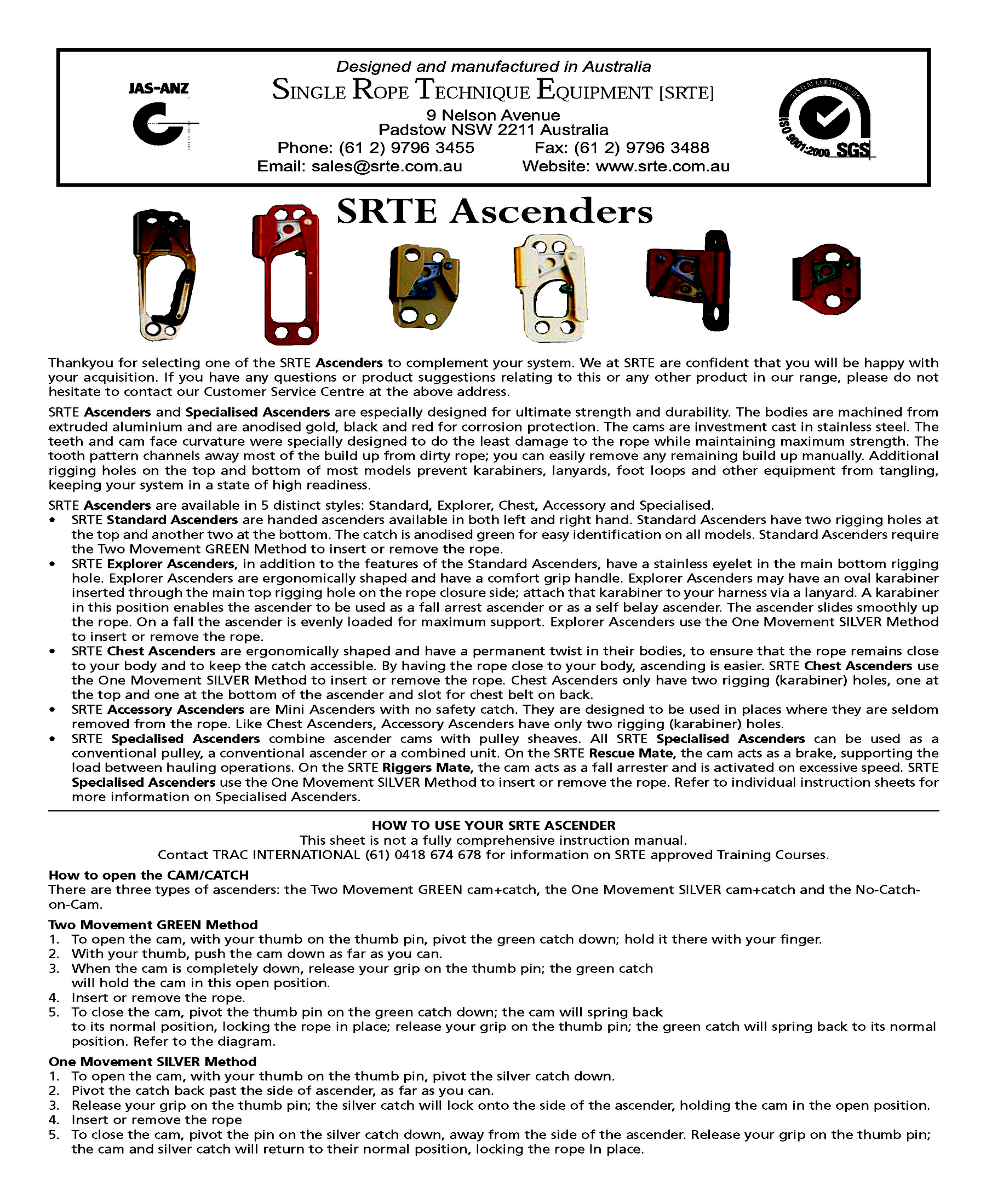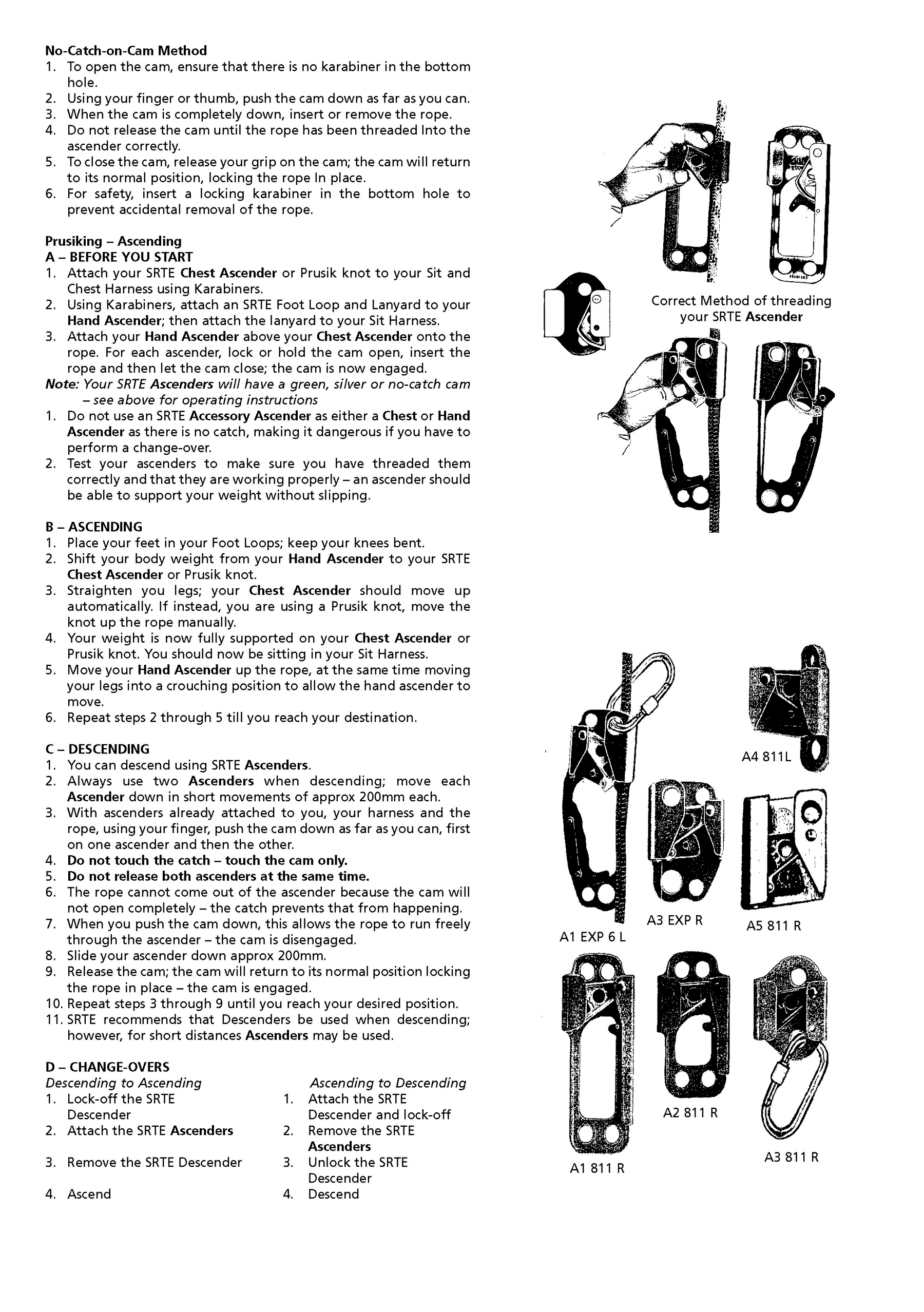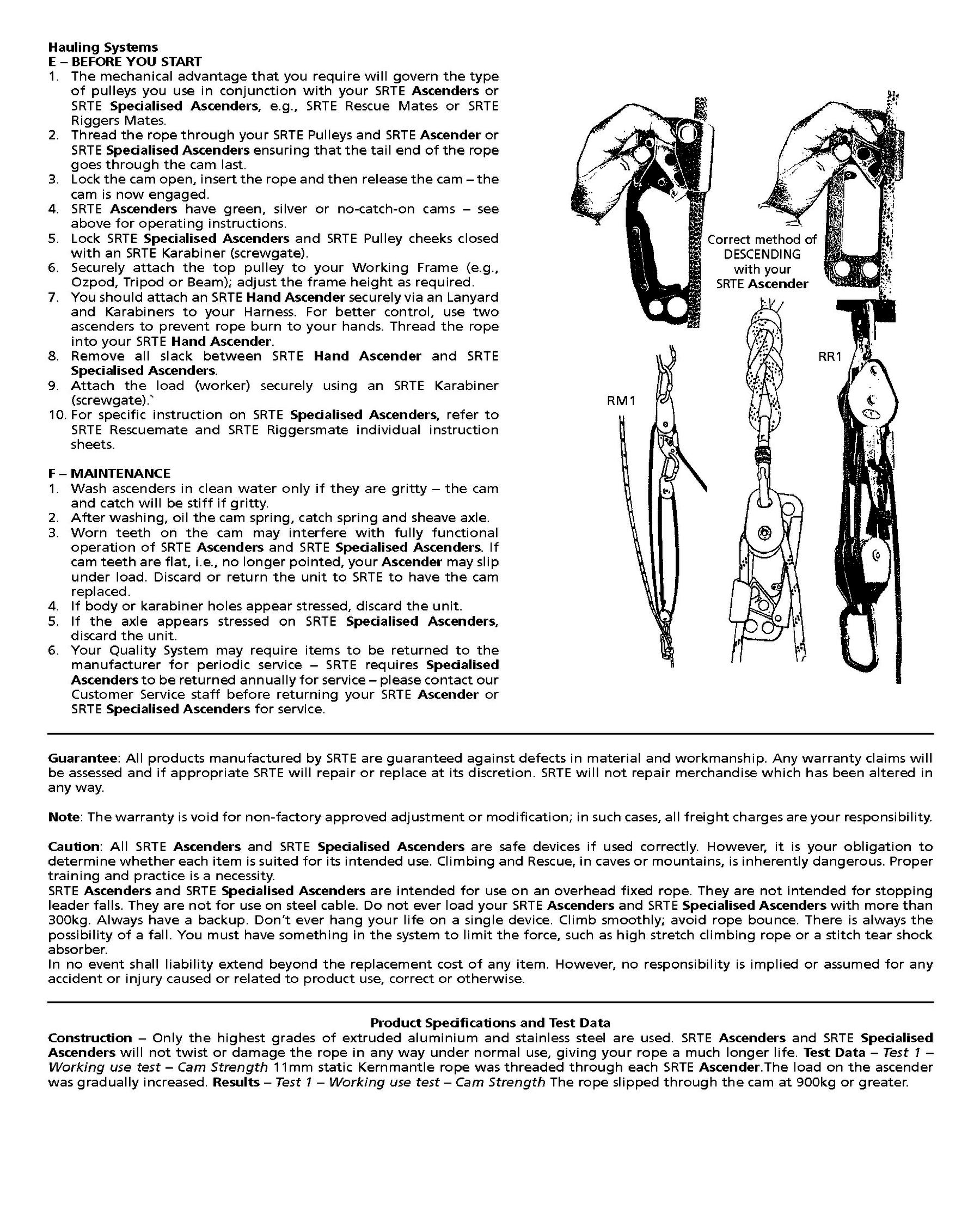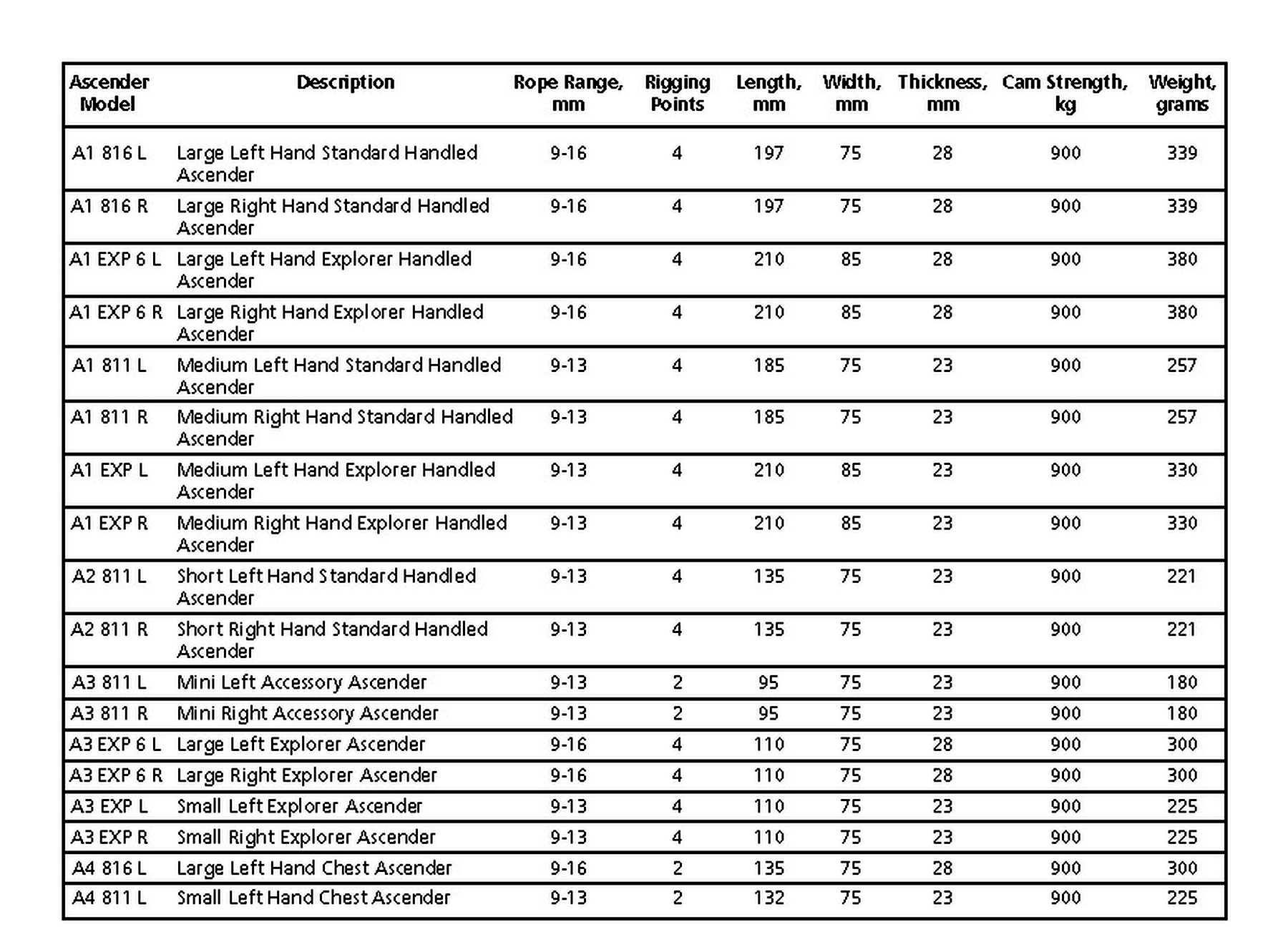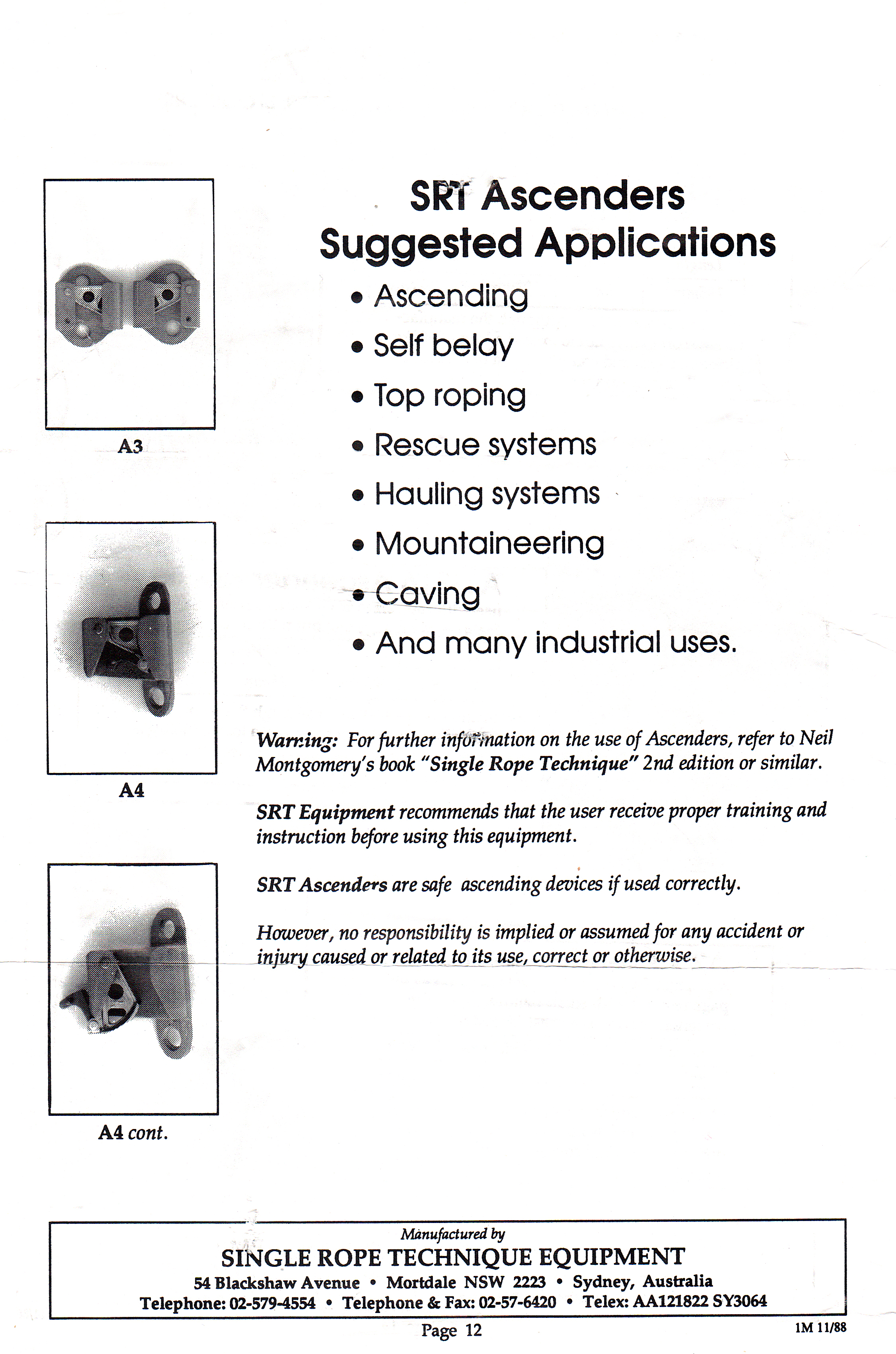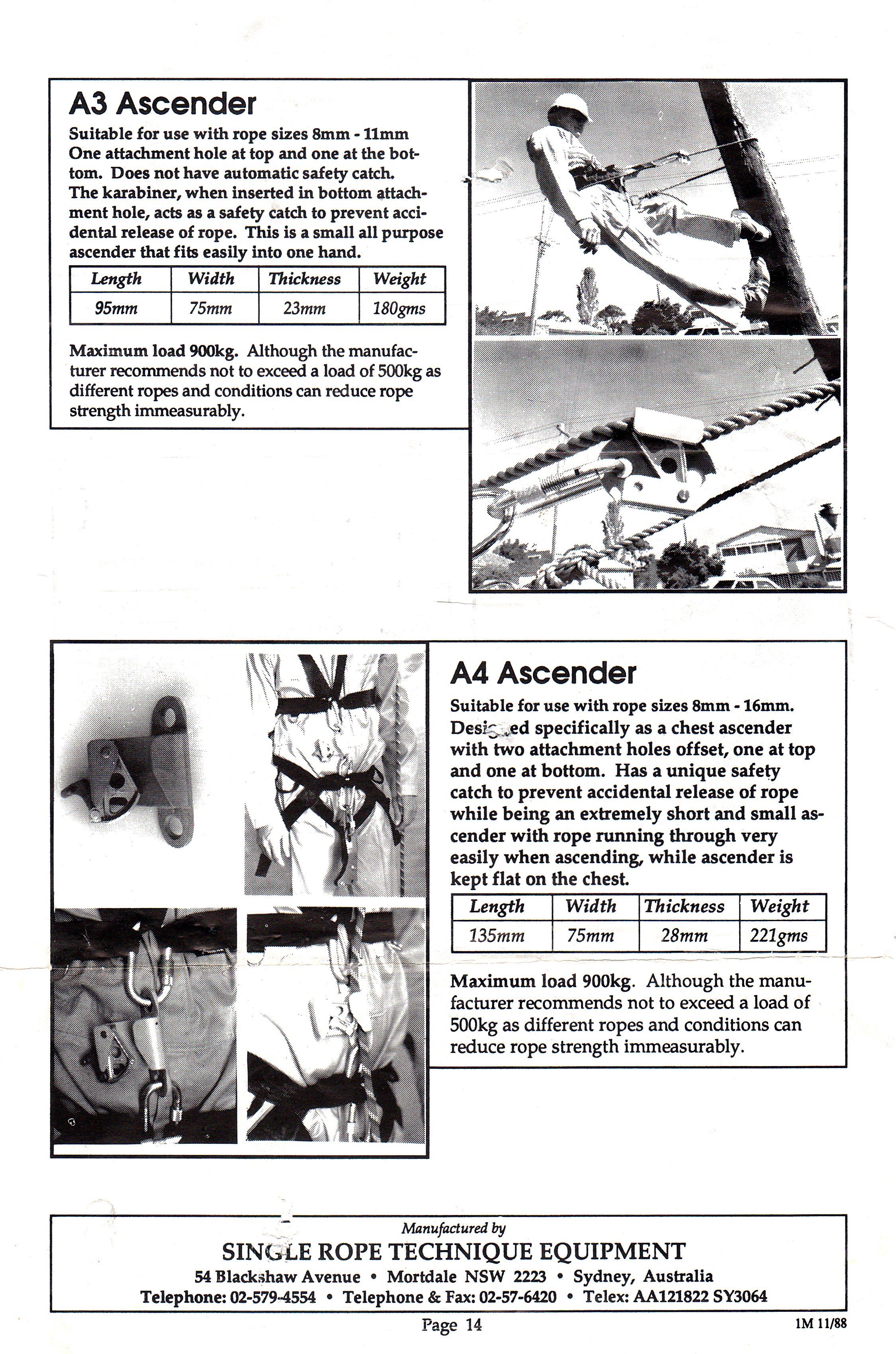Overview
History
Boris Rogelja founded Single Rope Technique Equipment (SRTE) in 1980. Capital Safety Group acquired SRTE in 2011 and their devices started showing DBI-SALA, Capital Safety, and/or Rollgliss™ markings. Some of these continued to show SRTE markings, and some did not. There does not appear to be a specific date when the markings disappeared. Different devices removed the SRTE logo at different times. 3M acquired the Capital Safety Group in 2015 and the Single Rope Technique Equipment markings disappeared completely.
[ Top
| G.P. Version B
| A3 Explorer, Version A
| A3 Explorer, Version B
| A3 EXP 6 Explorer
| Return to E.C. Ascenders
]
G.P. Version A
(#16)
Technical Details
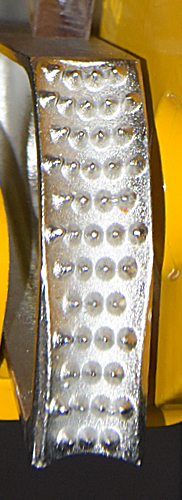 I obtained my G.P. from Inner Mountain Outfitters at the 1988 Old Timers Reunion. I acquired another pair in 2017 as part of Bob Thrun’s collection.
I obtained my G.P. from Inner Mountain Outfitters at the 1988 Old Timers Reunion. I acquired another pair in 2017 as part of Bob Thrun’s collection.
My pair consisted of two left-handed ascenders, although a left
and a right were supposed to be packaged together. Each ascender
is is 96 mm. high, 76 mm. wide, 26 mm. thick, and weighs 176 grams.
The shell is milled from a custom aluminum extrusion which appears
to be a direct copy of CMI’s extrusion.
The shell body is 6.5 mm. thick and painted yellow. The rope groove
is 14.2 mm. in diameter and U shaped. The cam mounting groove
is rectangular. Two cam pivot holes are provided; one for the
left and one for the right-handed configuration. The attachment
points are 15.5 mm. beveled circular holes, one located below
the cam and one above.
The cam is a plated skeletonized, reinforced stainless steel
casting with a (4.5)3(4.3)3 conical tooth count. The teeth axes
are perpendicular to the cam face. The cam radius, measured from
the pivot, increases from 41 to 58 mm. over an angle of 42 degrees.
The cam, cam spring, and a cam housing are mounted on a 6.4 mm.
semi-tubular rivet (the pin with retaining ring seen on the right ascender is a modification described in the comments). The cam pivot is centered 55 mm. from the inside of
the rope groove. A single spring serves as cam spring and safety
spring. The cam housing is a piece of thin sheet metal bent to
cover the top of the cam channel and serve as a spacer along the
sides of the cam. The top of the housing is indented; this limits
cam closing so that the teeth do not hit the inside of the rope
channel. There is no cam safety.
The inside of the shell is
stamped "SRT," "AUSTRALIA," and "EQUIP." There is a kangaroo cast into each side of the cam.
The SRT is a compact, well made ascender. The carabiner attachment
eliminates the need for a cam safety in the same manner as that
on the Clog. The extrusion is so similar
to CMI’s that the CMI
Optional Safety Kit can be installed on the SRT, although
it will allow the cam to open too far to prevent rope escape.
The attachment points are located too far from the main rope channel,
so ascender canting occurs, losing efficiency. The cam is very
well made, reminiscent of Jumar’s.
I'm not thrilled with semi-tubular rivets for cam pivots, but at least
the SRT’s are not cracked. The cam housing is lightweight and
crude, and on one of my ascenders had been trimmed with pliers.
The resulting sharp edges were not smoothed.
I was rather surprised when I received my pair in 1988 and discovered that SRT had packaged
two left-handed ascenders together. The orientation of the stampings
on the ascender shells showed that one of the pair was assembled
upside down, making a perfectly functional left-handed ascender
out of a right. If SRT had used a pivot pin like CMI’s,
the cam could have been easily reversed. Fortunately, I had a set
of extra CMI Shorti pins, so
took the reversed ascender and drilled out the semi-tubular rivet, then
reassembled the ascender as a right-handed model using the CMI Shorti pin. This incident seemed quite
atypical of of SRT’s normally excellent quality control, and I'm
sure that I could have simply gotten an exchange if I had chosen.
[ Top
| G.P. Version A
| A3 Explorer, Version A
| A3 Explorer, Version B
| A3 EXP 6 Explorer
| Return to E.C. Ascenders
]
G.P. Version B
(#1969, 2120)
Technical Details
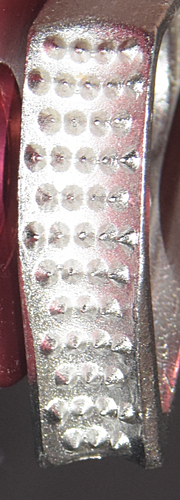 I acquired my Single Rope Technique Equipment G.P., Version B from Melody Dawson in 2013.
I acquired my Single Rope Technique Equipment G.P., Version B from Melody Dawson in 2013.
This version is 96 mm. tall, 76 mm. wide, 26 mm. thick, and weighs 182 g. The rope channel is 14 mm. wide. The cam radius increases from 40 to 58 mm. over an angle of 44°, giving a 26° cam angle. The tooth pattern is (4.5)^3(4.3^)3.
The inside of the shell is
stamped "SRT," "AUSTRALIA," and "EQUIP." There is a kangaroo, "UP," and an up-pointing arrow cast into each side of the cam.
This version is anodized instead of painted.
[ Top
| G.P. Version A
| G.P. Version B
| A3 Explorer, Version B
| A3 EXP 6 Explorer
| Return to E.C. Ascenders
]
A3 Explorer, Version A
(#2207)
Technical Details
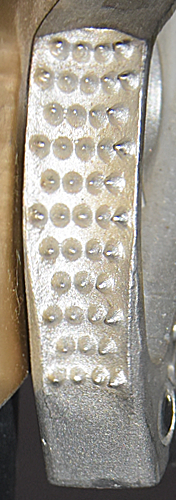 I acquired my Single Rope Technique Equipment A3 Explorer, Version A in 2017 as part of Bob Thrun’s collection.
I acquired my Single Rope Technique Equipment A3 Explorer, Version A in 2017 as part of Bob Thrun’s collection.
The Single Rope Technique Equipment A3 Explorer is 111 mm. tall, 78 mm. wide, 26 mm. thick, and weighs 229 g. The rope channel is 15 mm. wide. The cam radius increases from 41 to 57 mm. over an angle of 37°, giving a 27° cam angle. The tooth pattern is (4.5)^3(4.3)^2(4.F).
The rear of the body is stamped with "AUSTRALIA," "SRT" inside a map of Australia, and "PATENTED." The cam has a cast kangaroo.
The A3 Explorer is made out of the same extrusion as the G.P.,
but is larger and heavier. The extra size allows adding a cam
safety and extra holes, but I doubt that this is the best use
of the space. The A3 Explorer is smaller than the SRT
Climber, yet it weighs more. I would prefer that more of the
frame had been milled away, perhaps eliminating one each of the
top and bottom holes. Although this is a very solid ascender and
it is quite well-made, it could have been made much lighter.
All
of my A3 Explorers are right-hand models, but a left-hand model
was also available.
|
 |
If you can help me acquire a left-handed A3 Explorer, please email me. |
|
[ Top
| G.P. Version A
| G.P. Version B
| A3 Explorer, Version A
| A3 EXP 6 Explorer
| Return to E.C. Ascenders
]
A3 Explorer, Version B
(#18)
Technical Details
 I acquired my Single Rope Technique Equipment A3 Explorer, Version B from Inner Mountain Outfitters at the 1994 Speleofest.
I acquired my Single Rope Technique Equipment A3 Explorer, Version B from Inner Mountain Outfitters at the 1994 Speleofest.
Version B is 114 mm. tall, 78 mm. wide, 27 mm. thick, and weighs 239 g. The rope channel is 15 mm. wide. The cam radius increases from 46 to 62 mm. over an angle of 37°, giving a 25° cam angle. The tooth pattern is (4.3)^5(F).
The rear of the body is stamped with "AUSTRALIA," "SRT" inside a map of Australia, and "PATENTED." The cam has a raised up-pointing arrow labeled "UP" in raised letters, and "S R T" in raised letters.
Version B has a different cam with a new tooth pattern.
All
of my A3 Explorers are right-hand models, but a left-hand model
was also available.
|
 |
If you can help me acquire a left-handed A3 Explorer, please email me. |
|
[ Top
| G.P. Version A
| G.P. Version B
| A3 Explorer, Version A
| A3 Explorer, Version B
| Return to E.C. Ascenders
]
A3 EXP 6 Explorer
(#146)
Technical Details
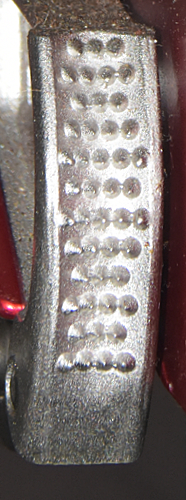 I acquired my Single Rope Technique Equipment A3 EXP 6 from Single Rope Technique Equipment in 2000.
I acquired my Single Rope Technique Equipment A3 EXP 6 from Single Rope Technique Equipment in 2000.
The Single Rope Technique Equipment A3 EXP 6 is 113 mm. tall, 82 mm. wide, 31 mm. thick, and weighs 280 g. The rope channel is 18 mm. wide. The cam radius increases from 41 to 61 mm. over an angle of 41°, giving a 29° cam angle. The tooth pattern is (3.4)^2(5.4)^2(3.4)^2(F).
The rear of the body is stamped with "S.R.T.," "AUSTRALIA, "EQUIP." and "19908901." The cam has a raised up-pointing arrow labeled "UP" in raised letters, and "S R T" in raised letters.
The A3 EXP 6 is a larger ascender made to work on 8 to 16 mm
ropes (the "bigger is
better" crowd will like this). As with the normal A3,
it could have been made much lighter if more of the frame had
been milled away.
[ Top
| G.P. Version A
| G.P. Version B
| A3 Explorer, Version A
| A3 Explorer, Version B
| A3 EXP 6 Explorer
]



